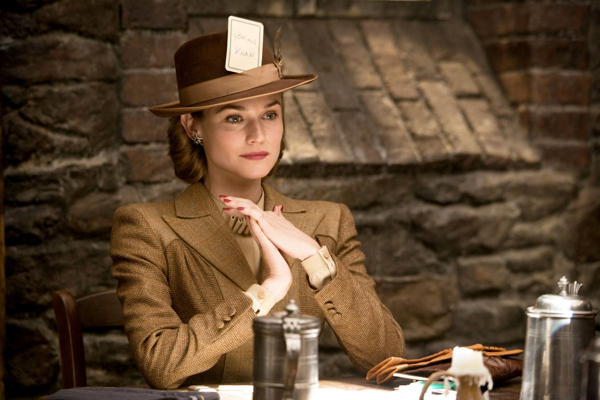Movie review by Greg Carlson
What many Quentin Tarantino fans had hoped would be the director’s dazzling genre deconstruction/reconstruction of Spaghetti Westerns and WW 2 action flicks unfolds as a sloppy, long-winded, and sometimes dull disappointment. Tarantino’s audacious stylistic flourishes continue to be applied with a virtuoso’s touch, but the purposefully misspelled “Inglourious Basterds” exchanges spectacle for an endless river of dialogue that prevents the film from ever fully taking cinematic flight. The film features plenty of breathtaking images and dozens of Tarantino’s intertextual tributes to favorite films obscure and famous, but the director’s narcissistic ardor for his own words paralyzes the two and a half hour marathon with bottomless scenes of talking, talking, and more talking.
Presented as episodic chapters that occasionally work better as individuated short films, the five sections of “Inglourious Basterds” contribute to an intertwined movie premiere bomb/arson plot that pits a bloodthirsty squad of Jewish trigger-men and a vengeful cinephile against no less than the top command of the German war machine, including der Fuhrer himself. Lt. Aldo Raine, played to the rafters by Brad Pitt, leads the cutthroat Basterds, but unlike major inspiration “The Dirty Dozen,” Tarantino seldom shows the whole group functioning together. With very few exceptions, the Basterds’ bloodiest exploits are also left up to the imagination.
In keeping with a tradition of velvety evil movie Nazis, Tarantino lavishes attention on Standartenfuhrer Hans “The Jew Hunter” Landa, a sophisticated detective whose bearing and screen time nearly make him the film’s ghoulish protagonist (QT admitted in a recent interview with Ella Taylor that he wanted to manipulate the audience into investing in the character’s successes to “see what he’ll do”). As inhabited by Austrian performer Christoph Waltz, Landa is one of the movie’s great pleasures, breathing new life into one of moviedom’s dustiest tropes. Both Waltz and Pitt are funny, but Tarantino’s application of humor is mostly queasy and indelicate, light years from the overshadowing genius of Lubitsch’s “To Be or Not to Be” – a film made during WW 2 that still sparkles with relevance six decades later.
At least two conflicting schools of thought inspire conversation about the movie’s political projections (to suggest an agenda would give the filmmaker too much credit). The first argues that the movie’s over-the-top Jewish revenge fantasy – which baseball bat-wielding Bear Jew portrayer Eli Roth has dubbed “Kosher Porn” – gleefully rewrites Third Reich history with a wink and a nudge. The second, more troublesome reading trades the reductio ad ridiculum of the first with the unsettling idea that Raine’s team of brutal thugs are no better than the Nazis they bludgeon and scalp. Their inhumane atrocities paint the Basterds as a 1940s version of al-Qaeda executioners or CIA torturers, unshackled from any moral consequence.
“Inglourious Basterds” is certainly at its finest when Tarantino’s penchant for self-reflexivity turns the act of watching into a game of “I Spy” for hardcore movie fanatics. A key British military operative played by Michael Fassbender is a movie critic and authority on German Expressionism in his civilian life. Highly flammable nitrate film prints are used as weapons. A well-known academic criticism of “King Kong” provides a clever jest that doubles as social commentary. Characters argue the merits of “The White Hell of Pitz Palu” and “The Kid.” Indulging his foot fetish and passion for theatrical liebestod, Tarantino even works in nods to the pre-cinematic mythologies of “Cinderella” and “Romeo and Juliet.” All these heady allusions guarantee long-term dissection of “Inglourious Basterds,” even if the movie does not live up to Tarantino’s auteurist reputation as a filmmaker’s filmmaker.
